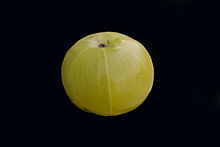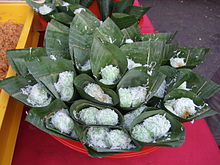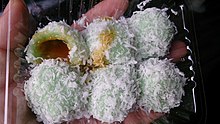 | |
| Alternative names |
(Malacca and Malaysia)
(Malaysia, Sumatra and Sulawesi)
(Singapore)
|
|---|---|
| Type | Kuih |
| Place of origin | Malacca |
| Region or state | Malaysia, Singapore and Brunei |
| Created by | Malacca Malay |
| Main ingredients | glutinous rice flour, pandan, gula melaka or gula nise, grated coconut, salt |
| Other information | Klepon, bua loi, mont lone yay baw, Khanom tom, tangyuan, modak |
Buah melaka or Onde-onde Peninsular Malay refers to a kind of traditional Kuih from Malacca, This kuih is shaped like a Melaka fruit Gooseberry. It is famous in Malaysia, also Singapore and Brunei.
This Kuih already create before the colonial era, that is after the city of Melaka/ Malacca was opened by Parameswara, the melaka tree became the pride of the people of Malacca until today. [1]


Buah melaka is inspired by the Melaka fruit tree which is ( Phyllanthus emblica) a species from the Gooseberry family. This kuih is based on glutinous rice flour, pandan leaves, melaka sugar and grated coconut. One of the culinary ingredients of the Melaka community is gula Melaka, this sugar has a high concentration in Malaysia compared to nise sugar ( gula nise) or kabung sugar ( gula kabung). That's why Buah melaka (Kuih) got its name from the appearance of melaka fruit and the combination of melaka sugar. [2]
This dessert is famous among Peranakan Chinese and Peranakan Indian in Malaysia namely Baba Nyonya [3] and Chetty, Malacca.
In addition to being known by the name Buah melaka (Kuih), it is also called Onde-onde which comes from the Portuguese word Onde-oande meaning everywhere in ( Bahasa Malaysia) mana-mana. [4] It is possible that when the Portuguese arrived in Melaka City, they ate Buah melaka (Kuih) and found melaka trees everywhere, then they name it as Onde-onde [ citation needed]. In Singapore call Ondeh-ondeh every word between e or ending word e they will add the letter H. While in Brunei call Kuih pancit because when eaten the sugar will splash.
In Kelantan they call it Onde-onde or Kekohcar, they don't use melaka sugar, they have their own sugar which is nise sugar gula nise which is the pride of Kelantan people.
In Sumatra and Sulawesi they also call it Onde-onde , they use gula merah or gula saka. After the Portuguese arrived in Malacca, they went to Sumatra and Sulawesi, it is possible that Onde-onde was spread by them. The Malacca Sultanate is very close to the Kingdom of Pasai and the Maluku Sultanate in the 15th to 17th centuries [ citation needed].
There is almost the same dish in Indonesia that is Klepon meaning animal ovary, the ingredients used are slightly different which is the addition of suji leaves, glutinous rice flour, rice flour and using Aren sugar, the sugar of the Javanese community. The terms they used are very different from the words Buah melaka and Onde-onde which are real in physical.



- ^ Shazlan Ahmad, Ahmad (7 October 2010). "Buah Melaka@Onde-onde Melaka's historical heritage". Sayang Melaka. Retrieved 11 July 2024.
- ^ Ahmad, Shazlan (18 July 2024). "Experience about Buah melaka". The Informal Chef. Retrieved 2 January 2015.
- ^ Ahmad, Shazlan (15 July 2024). "Famous Baba Nyonya Food in Malacca". Malaysia Mall. Retrieved 2 April 2018.
- ^ Ahmad, Shazlan (15 July 2024). "Onde-Onde/Onde-oande comes from Portuguese words". Itranslate. Retrieved 15 July 2024.
 | |
| Alternative names |
(Malacca and Malaysia)
(Malaysia, Sumatra and Sulawesi)
(Singapore)
|
|---|---|
| Type | Kuih |
| Place of origin | Malacca |
| Region or state | Malaysia, Singapore and Brunei |
| Created by | Malacca Malay |
| Main ingredients | glutinous rice flour, pandan, gula melaka or gula nise, grated coconut, salt |
| Other information | Klepon, bua loi, mont lone yay baw, Khanom tom, tangyuan, modak |
Buah melaka or Onde-onde Peninsular Malay refers to a kind of traditional Kuih from Malacca, This kuih is shaped like a Melaka fruit Gooseberry. It is famous in Malaysia, also Singapore and Brunei.
This Kuih already create before the colonial era, that is after the city of Melaka/ Malacca was opened by Parameswara, the melaka tree became the pride of the people of Malacca until today. [1]


Buah melaka is inspired by the Melaka fruit tree which is ( Phyllanthus emblica) a species from the Gooseberry family. This kuih is based on glutinous rice flour, pandan leaves, melaka sugar and grated coconut. One of the culinary ingredients of the Melaka community is gula Melaka, this sugar has a high concentration in Malaysia compared to nise sugar ( gula nise) or kabung sugar ( gula kabung). That's why Buah melaka (Kuih) got its name from the appearance of melaka fruit and the combination of melaka sugar. [2]
This dessert is famous among Peranakan Chinese and Peranakan Indian in Malaysia namely Baba Nyonya [3] and Chetty, Malacca.
In addition to being known by the name Buah melaka (Kuih), it is also called Onde-onde which comes from the Portuguese word Onde-oande meaning everywhere in ( Bahasa Malaysia) mana-mana. [4] It is possible that when the Portuguese arrived in Melaka City, they ate Buah melaka (Kuih) and found melaka trees everywhere, then they name it as Onde-onde [ citation needed]. In Singapore call Ondeh-ondeh every word between e or ending word e they will add the letter H. While in Brunei call Kuih pancit because when eaten the sugar will splash.
In Kelantan they call it Onde-onde or Kekohcar, they don't use melaka sugar, they have their own sugar which is nise sugar gula nise which is the pride of Kelantan people.
In Sumatra and Sulawesi they also call it Onde-onde , they use gula merah or gula saka. After the Portuguese arrived in Malacca, they went to Sumatra and Sulawesi, it is possible that Onde-onde was spread by them. The Malacca Sultanate is very close to the Kingdom of Pasai and the Maluku Sultanate in the 15th to 17th centuries [ citation needed].
There is almost the same dish in Indonesia that is Klepon meaning animal ovary, the ingredients used are slightly different which is the addition of suji leaves, glutinous rice flour, rice flour and using Aren sugar, the sugar of the Javanese community. The terms they used are very different from the words Buah melaka and Onde-onde which are real in physical.



- ^ Shazlan Ahmad, Ahmad (7 October 2010). "Buah Melaka@Onde-onde Melaka's historical heritage". Sayang Melaka. Retrieved 11 July 2024.
- ^ Ahmad, Shazlan (18 July 2024). "Experience about Buah melaka". The Informal Chef. Retrieved 2 January 2015.
- ^ Ahmad, Shazlan (15 July 2024). "Famous Baba Nyonya Food in Malacca". Malaysia Mall. Retrieved 2 April 2018.
- ^ Ahmad, Shazlan (15 July 2024). "Onde-Onde/Onde-oande comes from Portuguese words". Itranslate. Retrieved 15 July 2024.